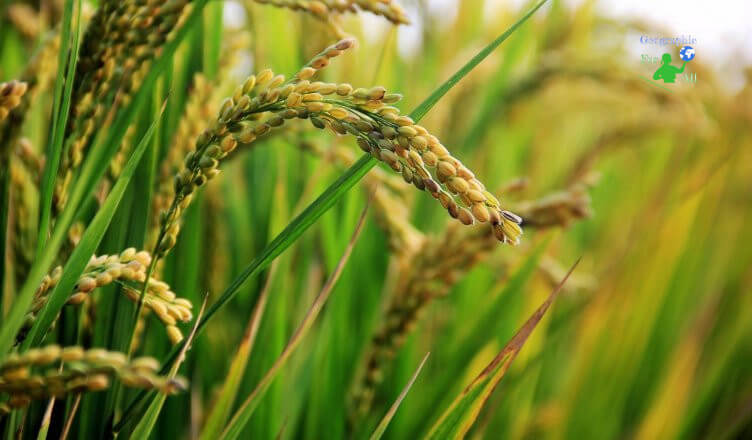Rice is the second most important cereal product after wheat. It is divided into wet (requires water all the time except harvest) and dry (does not need so much water). In addition, there are several edible species, e.g. red, black, white. Rice is eaten little processed because too intensive processing causes losses of vitamins and minerals. Straw is used for feed production and in the paper industry.

Soil
Rice grows best in fertile, low-draining, clayey soil that holds water. River muds best meet these conditions. Dry rice is less demanding and can grow in highlands and mountains up to 2000 m a.s.l. Wet rice is most often grown on terraced plots using overflow irrigation. Initially, the seeds germinate on ordinary beds, after 1-2 months they are transplanted into proper fields. The water mirror is about 5-10 cm high.
Climatic conditions and occurrence
Rice is mainly found in monsoon and tropical climates. Requires a minimum of 60 days with a temperature above 20 degrees Celsius (wet) or 90 days minimum 18 degrees (dry). The exact temperature range depends on the species, the minimum is 10-15 degrees.
The harvest is usually twice a year, three times a year or three times every two years.
The most and largest rice crops are:
- in Europe – Padan Plain, Guadalquivir River Valley (Spain)
- in Asia – the Ganges Plain (eastern and central part), Chinese Plain, Sichuan Basin, Indus Plain, Luzon, Honshu, Java, Nanling Mountains, deltas and valleys of the Yangtze River, of the Mekong, of Irawadi, of Menam
- in North America – the Gulf Plain (western part), Arkansas
- in South America – the state of Rio Grande do Sul in Brazil
- in Africa – Nile and Niger delta, Madagascar
- in Australia – the Murray River Valley
The overwhelming majority (90%) of the world’s collections come from Asia from the monsoon regions. This is due to a large amount of relatively regular rainfall, large population (both as workforce and consumers) and centuries-old tradition.

Yields
The average world yield in 2013 was 44.9 dt / ha, over 13 years it increased by 6 dt / ha. Nobody will be surprised by the fact that Asian countries enjoy the greatest productivity, although it is worth remembering the United States in second place. Over the past 13 years, the order given has changed slightly.
The highest yields per hectare in 2013:
- Egypt – 95.3 dt / ha
- USA – 86.2 dt / ha
- South Korea – 67.6 dt / ha
- Japan – 67.3 dt / ha
- China – 67.2 dt / ha
- Vietnam – 55.7 dt / ha
- Indonesia – 51.5 dt / ha
- Brazil – 50.1 dt / ha
- Bangladesh – 43.8 dt / ha
- Sri Lanka – 38.9 dt / ha
Producers
In 2013, a total of 740.9 million tons of rice were produced, which is 24.9 million tons more than wheat. In comparison with 2000, rice harvest was by 142 thousand tons larger. And like in the case of the crop ranking, Asian countries are in the lead. Although two main differences can be seen – South Korea, Egypt and the United States, despite high yields, do not produce as much grain, while Burma, the Philippines and Thailand have weaker crops per hectare, but they produce more.
The largest share in rice production had:
- China – 203 million tons
- India – 159 million tons
- Indonesia – 71 million tonnes
- Bangladesh – 51 million tons
- Vietnam – 44 million tons
- Thailand – 36 million tons
- Myanmar / Burma – 28.7 million tonnes
- Philippines – 18 million tons
- Brazil – 11.7 million tons
- Japan – 10.7 million tons
Exporters (2012)
- India – 10.47 million tonnes
- Vietnam – 8.02 million tonnes
- Thailand – 6.70 million tons
- Pakistan – 3.42 million tons
- USA – 3.25 million tons
- Brazil – 1.10 million tonnes
- Uruguay – 1.03 million tonnes
- Italy – 0.74 million tonnes
- Argentina – 0.61 million tonnes
- Myanmar / Burma – 0.46 million tonnes
The main exporters are usually the largest producers. The exceptions are China (import) and the United States and South America.
Importers (2012)
- China – 2.33 million tons
- Nigeria – 2.29 million tons
- Indonesia – 1.80 million tons
- Ivory Coast – 1.68 million tons
- Iraq – 1.38 million tons
- South Africa -1.29 million tonnes
- Saudi Arabia – 1.21 million tons
- Senegal – 1.04 million tons
- Iran – 1.03 million tonnes
- Philippines – 1.01 million tonnes
China is not only a leading rice producer in the world but also an importer – after all, it is one of the most populous countries in the world. In addition, rice is bought by African and Arab countries.
Source of data for 2013:
Rocznik statystyczny GUS 2015


0 Comments for “Plant cultivation – rice”